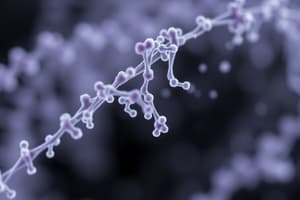Podcast
Questions and Answers
What method was mostly used in the past to answer questions about which parts of the genome are transcribed?
What method was mostly used in the past to answer questions about which parts of the genome are transcribed?
- Next-generation sequencing
- Microarray (correct)
- DNA hybridization
- RNA-Seq
What is the advantage of a next-generation sequencing (NGS)-based approach over a hybridization-based approach?
What is the advantage of a next-generation sequencing (NGS)-based approach over a hybridization-based approach?
- Requires fewer computational resources
- Identifies all genomic regions with probe coverage
- Provides real-time transcriptional activity data
- Does not depend on the current annotation of the genome (correct)
What determines the genes or parts of the genome that are analyzed in a hybridization-based approach?
What determines the genes or parts of the genome that are analyzed in a hybridization-based approach?
- Transcriptional activity level
- Sequencing of the entire RNA population
- Repertoire of hybridization probes (correct)
- Reference genome mapping
How is RNA-Seq data analysis primarily based?
How is RNA-Seq data analysis primarily based?
What does the total number of reads mapped to a particular genomic region represent in RNA-Seq data analysis?
What does the total number of reads mapped to a particular genomic region represent in RNA-Seq data analysis?
Study Notes
Methods for Analyzing Genome Transcription
- In the past, hybridization-based approaches were mostly used to answer questions about which parts of the genome are transcribed.
Next-Generation Sequencing (NGS) Advantages
- NGS-based approaches have an advantage over hybridization-based approaches, offering a more comprehensive and unbiased view of the transcriptome.
Hybridization-Based Approach Limitations
- The genes or parts of the genome that are analyzed in a hybridization-based approach are determined by the probes or microarrays used.
RNA-Seq Data Analysis
- RNA-Seq data analysis is primarily based on the mapping of sequencing reads to a reference genome.
RNA-Seq Data Interpretation
- The total number of reads mapped to a particular genomic region in RNA-Seq data analysis represents the expression level of the corresponding gene or region.
Studying That Suits You
Use AI to generate personalized quizzes and flashcards to suit your learning preferences.
Description
Test your knowledge of transcriptomic analysis and microarray technology with this quiz. Explore the principles of hybridization-based approaches and the use of DNA probes for studying gene expression.




